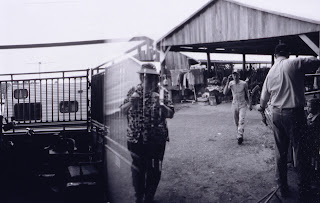Wednesday, January 16, 2013
Travel photos transformation
Part of my semester of art history study in Greece was, of course, creating a collection of photographic images. Due to the documentary nature of the project, plus the fact that our group would be in constant transition from place to place, the camera that I relied on was small and digital. I came home with around 3000 photographs.
I considered many of these images to be interesting, and many quite beautiful, but I also realized that it is difficult to produce images that are not beautiful in such a place. So, my photos looked like the photos that I have seen in art and history books for most of my life. I have never exhibited these images outside of class history lectures or the occasional web posting. Somehow, they did not seem real to me.
This image is realistic in the sense that we come to expect from photographs:
It is sharply focused
It has realistic color
It is a detailed recording of what was in front of the lens
However; the piece shows very little of the true experience involved with this time and place.
How can it communicate the sense of wonder, mystery, and awe?
Can one fraction of a second from one position through one lens sum up the complexity of emotion involved in this setting?
My decision is to recreate my images(if I can truly call them mine) from Greece in a way that seems more personal and less repeatable. In this sense, perhaps they will become a more realistic connection to that place and to my experience there. I hope that this project allows me to revisit some of the moments that I may have lost while concentrating on capture with one eye closed and the other looking through a small viewfinder.
For me, the image will become more important when it involves more time, preferably in the darkroom where I feel like one who makes marks on a dark cave wall. I will utilize a precious old companion to me, the pinhole.
On a side note, I made thirty prints today in the darkroom for the 2013 Post Card Exchange, sponsorered by the Post Card Collective Museum here:
http://www.postcardcollective.org/
I felt honored to be among the artists selected for this activity and it was a great excuse to use a pack of Ilford Postcard RC paper that was given to me by a dear friend (Kathleen Linkous.) The process for the image is another in which I combine digital and darkroom work. The original image was taken with a plastic Holga camera, developed and scanned, printed back out as a paper negative, and contacted printed onto the RC paper. Here is the image as it first appeared:
The postcard image will pick up fibers present in the paper negative and lose some detail due to the change of generation. Will that make the image more or less related to "reality?" Maybe we can figure that out. Thanks for reading and more about pinhole next time...
http://www.youtube.com/watch?v=wq2e7DPhyHg
Subscribe to:
Post Comments (Atom)



No comments:
Post a Comment